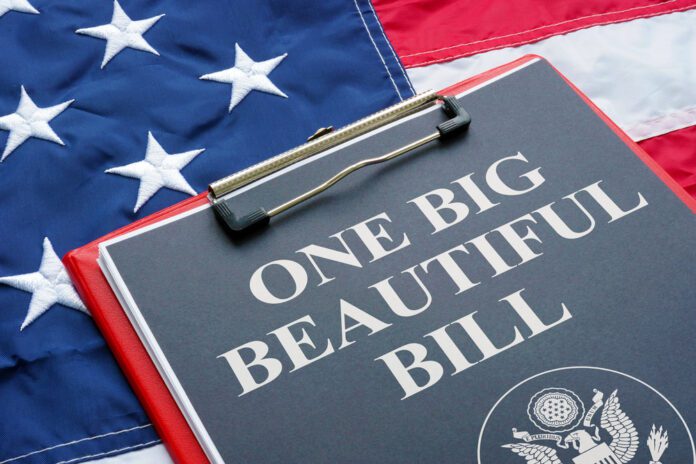
On July 4, President Trump signed the One Big Beautiful Bill Act (OBBB), unleashing a wave of outrage across the globe. Many critics describe it as a fiscal overhaul disguised as reform, one that locks in $4.5 trillion in tax cuts over the next decade, with the overwhelming share going to corporations and high-income earners. To close the resulting $1.7 trillion revenue gap, the bill slashes social safety nets such as Medicaid and SNAP, imposes new work requirements, shifts administrative costs to the states, and cuts programs vital to the most vulnerable. The effects are stark: analysts estimate 11.8 million people will lose health coverage and more than 3 million will lose food assistance. According to the Yale Policy Institute, the bottom 20% of earners will see their after-tax income fall by 2.9%, while the top 20% will enjoy a 2.2% increase. Tax hikes on university endowments, surcharges on remittances, and the removal of clean energy subsidies further erode support for education, environmental protection, and immigrant communities. For opponents, the bill is a form of reverse redistribution—taking from those with the least to give more to those with the most—and a deliberate dismantling of the neoliberal-welfare state. Some go further, arguing it does not make America great again, but rather strengthens America’s rivals.
Many professors at Harvard, Yale, and Princeton described Trump’s agenda as a battle to defend America. This battle may not unfold exactly as Trump envisions, but for him and his allies it represents the final opportunity to preserve what they consider America’s core identity. The question, then, is what exactly is being defended, and whose America it is. Trump, as the product and champion of the “Make America Great Again” movement, speaks to a vision rooted in the country’s Anglo-Protestant heritage—English language, Christianity, the British legal tradition, limited government, individual rights, Protestant work ethic, and the literary and philosophical traditions of Europe. For centuries, immigrants arrived to find an America already built on this cultural framework. Until the twenty-first century, foreign-born residents averaged little more than 10% of the population, and the Anglo-Protestant core dominated the national ethos.
Over time, this ethos evolved into what Huntington and others have called “American beliefs”: liberty, equality, democracy, individualism, human rights, the rule of law, and private property. These ideals were shaped by a Puritan tradition of dissent, giving them an especially defiant and independent character. In the twentieth century, the phrase WASP—White Anglo-Saxon Protestant—was used to describe America’s most powerful cultural and economic elite. But in recent decades, demographic changes, civil rights movements, and a growing embrace of multiculturalism have weakened the dominance of this identity. The melting pot metaphor gave way to diversity, equity, and inclusion—values embraced by much of the left but resisted fiercely by the MAGA movement.
Samuel P. Huntington, long before Trump, warned that the erosion of America’s shared identity was a threat to its survival. In The Clash of Civilizations, he argued that future conflicts would be defined less by ideology or economics than by cultural fault lines. Later, in Who Are We? The Challenges to America’s National Identity, he turned that lens inward, warning that without shared racial, ethnic, cultural, and ideological foundations, America would lose the cohesion needed to endure. While the Cold War’s threats were external, today’s, he argued, come from within. Without a renewal of national identity, the United States risked the fate of once-mighty civilizations like Sparta and Rome.
Seen in this light, the OBBB is more than a fiscal policy—it is a political instrument aimed at restoring a vision of America aligned with Trump’s cultural and ideological worldview. Its domestic measures cut not across the entire working class, but focus on those dependent on welfare. Trump’s philosophy echoes a Protestant belief that benefits should be earned, not granted as innate rights. The bill also strikes directly at the Democratic Party’s policy architecture, and at universities and intellectual circles that Trump sees as breeding grounds for “un-American” values. Education provisions tighten Pell Grant rules, abolish federal graduate and parent loans, and impose borrowing caps—$100,000 for master’s degrees and $200,000 for doctorates—measures that disproportionately harm low- and middle-income students, especially from minority backgrounds. Moody’s forecasts that historically Black institutions like Meharry Medical School could face crippling deficits due to reduced domestic loan availability and high rejection rates for international students.
These financial levers are accompanied by ideological ones. The administration has withheld federal funds from elite universities accused of antisemitism or tolerating pro-Palestinian protests, demanded access to student group records and curricula, and in some cases required loyalty pledges. In effect, universities are being pushed away from serving as independent centers of knowledge and criticism toward functioning as extensions of state ideology. Diversity, equality, and inclusion agendas have been stigmatized, public intellectuals marginalized, and higher education reshaped to favor elite institutions aligned with Trump’s vision.
Internationally, the bill’s logic demands other sacrifices. Trump has openly distanced the United States from traditional allies, arguing they rely on American protection without fairly sharing the burden. This departure from the alliance system—long seen as the foundation of US-led global order—has unsettled much of the West. His administration has withdrawn from UN agencies like UNESCO, abandoned the Paris Climate Agreement, sidelined the World Trade Organization, and rejected the consensus that America’s hegemony depends on a web of international commitments. Developing countries have also been hit: immigration restrictions reduce the flow of students and skilled workers, while reindustrialization policies undermine the export-driven industrialization strategies on which many economies depend. Where postwar America spurred growth abroad through initiatives like the Marshall Plan, today’s policies turn the US from a driver of global industrial growth into a competitor and obstacle.
The OBBB thus attempts to answer three intertwined questions: whose America is being protected, who governs it, and where it is heading. But even with a fractured Democratic Party, its success is uncertain. American politics itself is fractured, not only between parties but within them. Alliances are unstable; populism is volatile. Billionaires like Elon Musk have formed rival political movements, and scandals have created fissures even within the MAGA base. Populism brought Trump to power, but unmanaged, it could unseat him just as swiftly.
The economic foundations of the plan face their own risks. Trump’s strategy relies on empowering capital to generate wealth, pay down debt, and rebuild the white middle class. Yet America’s problems stem in part from the outsized power of capital, and granting it more freedom could deepen inequalities rather than resolve them. Technological change compounds the challenge: automation, artificial intelligence, and the platform economy are eroding jobs and concentrating wealth in the hands of a few tech giants, trends that work directly against the goal of broad middle-class revival.
Underlying it all is Trump’s vision of a small government and deregulated economy, echoing the Reagan Revolution of the 1980s. But many of the crises America faces today—inequality, weakened public institutions, and fraying social cohesion—are products of that earlier era. From a structural perspective, the country’s economic base remains strong; its real problems lie in its political superstructure and social relations. Attempting to repair those by weakening the state’s capacity risks accelerating decline rather than reversing it.
In the end, the OBBB is both an economic blueprint and a cultural manifesto. To its supporters, it is the last stand for a vision of America rooted in shared heritage and national purpose. To its critics, it is a regressive assault on fairness, pluralism, and the global role the US has played for nearly a century. Whether it secures a revival or speeds fragmentation will depend not only on the size of its tax cuts or the depth of its spending cuts, but on whether the identity it seeks to defend can survive in an America that has already changed beyond recognition.
Source: IPP, Yahoo, The White House



